|
REFLECTIONS ON THE GREAT WAR COMMEMORATIONS
FROM A BRIGADE MAJOR’S PERSPECTIVE
by Lieutenant Colonel D M Hannah MBE
Irish Guards
|
The Service at Westminster Abbey to mark the Centenary of the Armistice on the evening of Sunday 11th November 2018, in the presence of HM The Queen and The President of the Federal Republic of Germany, concluded over four years of Great War centenary events. Fittingly, the over-riding themes of the Service were reflection and reconciliation. This was articulated with refreshing clarity by the Archbishop of Canterbury in his address to a packed congregation consisting of a broad cross section of the British society that has engaged wholeheartedly in commemorative events, large and small, ambitious and modest, local, national and multinational. The breadth and range of events has been astonishing but appropriate given the global scale of The Great War and its effects, which were felt at every level and continue to have repercussions and more importantly, resonance today.
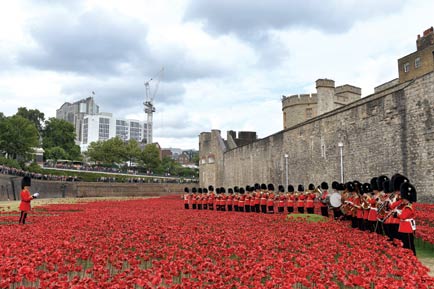 The Band of the Welsh Guards at The Tower of London. August 2014 The Band of the Welsh Guards at The Tower of London. August 2014 |
The Household Division played a central role throughout The Great War and has played a full part in these centenary commemorations. The publication in 2016 of Simon Doughty’s excellent book The Guards Came Through was a timely contribution to recording the Household Division’s contribution in a wonderfully consolidated manner, which adds considerably to both the traditional regimental histories and the more detailed analyses elsewhere.
The original direction to conduct a series of formal centenary commemorative events was taken by the Prime Minister, David Cameron, advised by a committee of prominent academics, including Professor Sir Hew Strachan and various retired military peers. The Department for Digital, Culture, Media and Sport (DCMS), was designated as the lead of a cross-government project led by Lord Ashton, the Parliamentary Under-Secretary of State for DCMS, with the aim of ‘remembrance, youth and education’, recognising the sacrifice, bloodshed and horror of war along with the importance of the hard-won victory and its responsibilities for protecting peace.
The Ministry of Defence role was coordinated by PS12 and it was fortuitous that the key individuals throughout were three Guardsmen, Lieutenant Colonel Mike Vernon, Coldstream Guards, and Lieutenant Colonel Charles Craig-Harvey, followed by Lieutenant Colonel Stephen Segrave, both Micks and all ideally suited to navigating through the inter-departmental and tri-service dynamics involved in the planning, preparation and delivery of events, unified in intent and tone while differing in detail.
The selection of events to commemorate was a challenge; there is probably an interesting article to be written on this topic alone. For each year, there was a key centenary event for National commemoration. In 2014, it was Saint-Symphorien in Belgium, marking the outbreak of war and the first shots fired by the British Expeditionary Force at Mons (where, by strange coincidence, the first and last British Army soldiers were killed, and are now buried close by in the Commonwealth War Graves Commission cemetery).
In 1915, it was Gallipoli, with appropriate recognition of the campaign’s significance to Australia and New Zealand, with Jutland and the Somme being obvious choices for their respective centenaries in 2016. Passchendaele (3rd Battle of Ypres) was the focus for 2017, offering the opportunity to mark all the battles of the Ypres Salient where most British Army regiments served at some stage in defence of the last major Belgian town in Allied hands. Amiens was the choice for 2018 as this battle, launched on 8th August 1918, marked the start of Allied advances that contributed significantly to the Armistice 100 days later.
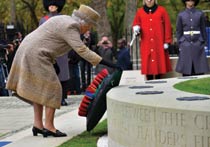 HM The Queen laying a wreath at
HM The Queen laying a wreath at
the opening of the Flanders Garden.
November 2014 |
Formal services at Westminster Abbey were identified as the way to mark commemorations in the capital, with a particularly poignant service at Westminster Abbey timed to mark the exact centenary, in both time and date, that the initial attacks were launched on the Somme, complete with a gun salute by the King’s Troop, Royal Horse Artillery and whistle blasts throughout the Abbey, evoking the signal blown by officers as they led the thousands of troops ‘over the top’.
Much of this took place during my time as the Brigade Major so I am delighted to be invited to share a few reflections on the main commemorative events and their planning with which I was privileged to be involved, plus some observations on other key events which had significance to the Household Division.
It is worth starting with the observation that the need to commemorate is nothing new; in the form of statues and memorial tablets it stretches back in visible form to ancient days, but it is one that has evolved over the ages. Traditionally, military events of significance have been commemorated with monuments like Nelson’s column, statues such as the Crimean War statue of Guardsmen at The Battle of Alma in Pall Mall, paintings, exemplified by the many works of Lady Butler and even annual banquets, such as the Trafalgar and Waterloo Dinners.
The scale of The Great War demanded something different and it changed and shaped our national commemorative culture. Although the Armistice in November 1918 was greeted with relief by soldiers at the Front and with pealing of church bells and rejoicing across the Allied nations, these celebrations gave way quickly to a more complex mixture of emotions. Britain and her Empire had suffered almost a million casualties. The decision not to repatriate British dead gave rise to the Imperial War Graves Commission, now the Commonwealth War Graves Commission (CWGC), inspired by Sir Fabian Ware, (whose Commissioners now include Vice-Admiral Sir Timothy Lawrence, as Vice-President, and Lieutenant General Sir Bill Rollo, formerly The Blues and Royals). The extraordinary work of the CWGC deserves the greatest recognition, not least as they provided the setting for most of the national centenary events, made possible by the dedication from staff of many nations who maintain them in such exemplary and fitting fashion.
In the aftermath of war, the need to focus individual and national grief was recognised and inspired the Cenotaph designed by Sir Edwin Lutyens with its simple but poignant inscription The Glorious Dead. Shortly afterwards, thanks to the inspiration of The Reverend David Railton MC, the Tomb of the Unknown Warrior was established (Railton’s story has been told by Andrew Richards, formerly The Life Guards, in his book The Flag; an article appeared in the Summer 2017 edition of The Guards Magazine). Railton had shared his idea with The Dean of Westminster who enlisted the support of David Lloyd George who in turn sought The King’s blessing. The story of the selection process is remarkable: bodies of several unidentified British soldiers from the battlefields of Flanders and France were exhumed and laid out in a makeshift chapel, with one selected by a blindfolded senior officer before being placed in a coffin, draped in a Union Flag that Padre Railton had used for burials in the field (and now hanging in Westminster Abbey), and then escorted, with full military honours across the Channel on a destroyer before being brought by train and then on a gun carriage to Westminster Abbey, attended by a Guard of Honour formed by one hundred holders of the Victoria Cross. The Unknown Warrior was buried in the Abbey, his coffin covered with soil brought from the battlefields of the Western Front. The queue for the public to pay respects was several miles long for days afterwards to allow tens of thousands of the British public to file past in an act of homage which was, in all too many cases, as much personal as national.
 The vigil at the Tomb of the Unknown Warrior. Westminster Abbey. 1st July 2016
The vigil at the Tomb of the Unknown Warrior. Westminster Abbey. 1st July 2016 |
The annual National Act of Commemoration at the Cenotaph, on the Sunday closest to 11th November, with the two minutes’ silence at 11 o’clock (the suggestion of The King), has become the focus of our commemorations for all those lost in war. It has arguably, and possibly justifiably, become one of the cornerstones of our State Ceremonial calendar, attracting veterans, families of veterans, and the public, and led by the Sovereign and the Royal Family. In keeping with all great State occasions, this parade has evolved almost imperceptibly by, for example incorporating the commemoration of subsequent conflicts. Another example of subtle but significant change is how The Queen’s traditional role of leading the wreath-laying was delegated to The Prince of Wales in 2018 while Her Majesty continues to lead the National Commemoration from the Foreign Office balcony overlooking the Cenotaph.
Other events have grown alongside the Cenotaph commemoration. The Royal British Legion’s Festival of Remembrance on the evening before has become an institutional prelude, skilfully orchestrated (but not owned) by the Garrison Sergeant Major and the HQ LONDIST team and rehearsed, nowadays using many Reservists and delivered with great style and precision, despite the constraint on rehearsal time. The format has allowed traditional formats and perennial favourites to be combined with important messages about the Armed Forces, about the realities of military service, recognizing the cost and consequences for individuals and families. Sensitive handling of people and multi-media has evolved in technical innovation and substance, with film and photograph clips, voice recordings and lighting and other special effects. It allows due respect to the stiff upper lip approach to commemorations while embracing issues in an emotionally open manner, in keeping with today’s more expressive society. Important issues such as PTSD have been tackled in an enlightened and more sympathetic manner, with public support from The Dukes of Cambridge and Sussex which continues to make a great difference to veterans and serving personnel alike. This stands in contrast to the attitudes adopted towards those suffering from ‘shell-shock’ during and after The Great War, despite the noble work of the RBL and similar charities.
At the Festival of Remembrance, as with State Ceremonial and Commemorative events, the part played by an experienced BBC team, headed by Clare Popplewell, should not be underestimated. The success of the commemorations owes much to this team, whose partnership with the Household Division is valued by both parties and was recognised widely by the two BAFTAs won for the BBC team’s work on the Passchendaele/Ypres Commemoration in 2017.
The BBC’s inspired coverage helped to bring the commemorations to a worldwide audience. Another inspired initiative, ’Never Such Innocence’ launched by Lady Lucy French, a descendant of Field Marshal Sir John French, aimed to encourage children to study and learn about The Great War, using art, poetry, music and drama. The Household Division was delighted to support this by hosting the annual prize winners’ event at Wellington Barracks, in the Guards’ Chapel, with visits to the Guards Museum and reception in the Officers’ Mess.
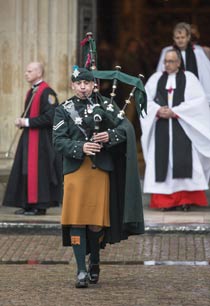 Lance Corporal Richie Spence, Irish Guards, at the Somme service, Westminster Abbey, 1st July 2016
Lance Corporal Richie Spence, Irish Guards, at the Somme service, Westminster Abbey, 1st July 2016 |
Andrew Wallis and the Guards Museum showed similar initiative in cooperation with the Flanders Regional Government, by establishing the Flanders Memorial Garden at Wellington Barracks, using soil from the Flanders battlefields. This, and its associated centenary celebrations and exhibitions provide a fine example of how well-run regimental museums can be important ‘soft power’ players on the national and international stage, entirely in keeping with their wider role and mandate.
An important recent commemorative development has been the Indian Army Memorial Gate. As David Lloyd George wrote, praising the role of all the 2.5 million Empire troops who answered the call, ‘had they stayed home, the issue of the War would have taken a different course’. Recognising the contribution of the Indian Army and all Empire and Commonwealth troops, in both world wars, is an increasingly vital bond that unites the Commonwealth and resonates through to today as a common bond that stretches across the world. Similarly, the contribution of Ireland has vital relevance for today, (by no means just for those of us who are proud to belong to Irish regiments) and this was demonstrated clearly at the Messines Ridge Commemorations in 2017 attended by The Duke of Cambridge and the then Taoiseach, Enda Kenny.
The Great War Centenary Commemorations of the outbreak of war were heralded by the publication of numerous books with many others marking different events, anniversaries and perspectives, recording and re-evaluating the demise of a gilded European era. This academic reflection and occasional re-appraisal of events in the light of history and modern perspective should be welcomed as there is, perhaps surprisingly, much to be learned from The Great War which is relevant to the challenges the British Army faces today. This ‘conceptual component’ was exploited enthusiastically with a series of Army Staff Rides studying key battles and lessons, drawing contemporary parallels, not least the challenges of preparing forces in an age of rapid technological innovation and development and the challenges of rapidly expanding, training and deploying armies.
The Army Staff Rides ran throughout the four-year period and grew progressively in scale and ambition, with the most recent one in October 2018 involving several hundred participants principally from the UK, France, Germany and the USA, but also from Commonwealth nations. Military participation ranged from Army chiefs to non-commissioned officers.
These events were supported by the State Bands (ably led by the Senior Director of Music, Lieutenant Colonel Kevin Roberts), continuing the tradition of their forebears who performed in support of troops on the Western Front and in the victory parades after the Armistice. The vital role of the State Bands supporting the Centenary Commemorations cannot be understated. Over the past year, my role as the British Liaison Officer to the French Army HQ has involved attending numerous French parades supported only by pre-recorded music which adds little to the dignity of ceremonial events. By contrast, our State Bands proved repeatedly at commemorations, large and small, that they are formidable assets, for the Household Division, the Army, and indeed the nation and they are the envy of many. Their collective skill, whether playing It’s a long way to Tipperary at Beating Retreats or George Butterworth’s The Banks of Green Willow at the Somme’s Thiepval Memorial, was invariably professionally polished and effective in the most sophisticated and evocative manner, tapping into human emotions in a way that only the best of musicians can achieve.
The planning of the commemorations was the overall responsibility of DCMS, with the Household Division team (The Brigade Major, SO2 Ceremonial, and the Garrison Sergeant Major) being an integral part of this process, charged with contributing practical suggestions on the best use of the military assets available for the ceremonial delivery of the commemorations. Tact and diplomacy were required along with a great deal of time, on top of the usual demands on this small and busy team. The fact that the Somme and Ypres commemorations fell on 1st July 2016 and 31st July 2017 respectively, meant that the fast tempo of State Ceremonial events was extended into the Summer for two years. London District troops coped admirably with the considerable extra demands imposed. Similarly, HQ LONDIST staff carried their share of the burden, playing a vital role in the planning, support and delivery of the commemorative events, with the Commander Log Support team and the O&D duo, Major Tom Pauncefort and Captain Jamie Harle, deserving mention.
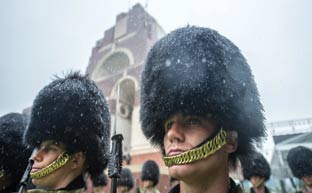 Irish Guardsmen in the rain at the Memorial to the Irish Guardsmen in the rain at the Memorial to the
Missing of the Somme, Thiepval. 1st July 2016
|
There were times when DCMS aspirations and agendas needed to be quietly ‘influenced’ from a military perspective. One example was a request that, for the finale of the son et lumière staged against the backdrop of the Cloth Hall at Ypres, the Guard of Honour should slow march through the town with rifles reversed, as though for a military funeral, while supposedly representing all the troops who marched up the Menin Road to the front line. A more appropriate finale was collectively designed and implemented whereby the Mick company, in service dress rather than tunics and bearskins, quick-marched with resolute steps, under spotlights, drill boots echoing from the cobbles, through the packed crowds and out through the Menin Gate, to the haunting strains of The Armed Man by Carl Jenkins. It was a moving and deeply evocative vignette, a fitting tribute paid by Guardsmen to all those troops, of all capbadges, who marched along that route during The Great War.
These events were delivered with dignity and style. There were many high points, but some stand out. For example, Thiepval, for Somme 100, with the evening service leading into an overnight vigil; the King’s Troop, in khaki with their First World War vintage 6-pounders, the lone Mick piper, Lance Corporal Ritchie Spencer, who had been wounded in Afghanistan, playing atop the towering Thiepval Memorial and the two Guards of Honour, one provided by French Officer Cadets from St Cyr, resplendent in blue tunics and red trousers, uniforms similar to those the French Army wore in 1914, next to the Micks in tunics and bearskins.
From Ypres 100, the traditional Menin Gate Last Post, sounded as usual by the volunteer buglers of the Ypres Fire Brigade, in keeping a long tradition only interrupted by four years of Nazi occupation, was as moving as ever, witnessed by many thousands, and led by The King of the Belgians and The Duke of Cambridge. This was followed by the stunning Cloth Hall Son et Lumière to which the Mick Guard of Honour contributed so evocatively before parading the next day at Tyne Cot for the Drum Head Service in the largest CWGC cemetery in the world. The Prince of Wales led the British wreath laying in blazing sunshine, in stark contrast to the Somme in 2016 when we experienced torrential rain and mud. On that occasion, the Brigade Major and Garrison Sergeant Major forced a passage through the crowd along a path that had turned from gravel to trench mud. That neither The Prince of Wales nor The Duchess of Cornwall appeared the slightest perturbed by this speaks volumes about their calm professional approach to their duties, their forbearance - and their sense of humour. This was displayed again by the Prince of Wales the following year at Tyne Cot, when a last minute, unplanned DCMS addition to the programme resulted in HRH, accompanied by the King and Queen of Belgium and the Duke and Duchess of Cambridge, having to walk through a section of the outer cemetery which the National Youth Service had used as a picnic area - complete with the debris that goes with it…
The Household Division’s only involvement during 2018 was at the National Commemoration at the Cenotaph and the Anglo-French Centenary Commemoration at the Foch Memorial near Victoria Station. The latter marked 26th March 1918 when, confronted by the Kaiser’s last major offensive, it was decided to place all Allied forces under a single ‘Generalissimo’, Marshal Ferdinand Foch, a decision vital to breaking the German offensive and launching the successful campaign that led finally to the Armistice. The Centenary Commemoration held at the Foch Memorial was a relatively small event, constrained by proximity to busy roads in Victoria, but it merits mention because of the significance it holds for the increasingly close professional links between the French and British armies, an invaluable initiative given the uncertainties elsewhere.
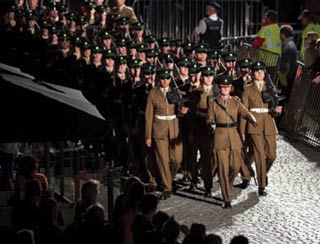 The Irish Guards marching through the Grande Place in Ypres The Irish Guards marching through the Grande Place in Ypres
at
the Ypres 100 commemorations
|
For the Amiens 100 Commemoration, the Major General argued compellingly that having delivered the bulk of the previous three years’ of events, and with the two major London District units already heavily committed to overseas exercises prior to rotating off the “Blue Line”, it was the turn of others to take the lead, ably supported by the Central Band of the Royals Air Force, in recognition of the RAF’s Centenary. As the Major General noted at the time, while the Household Division played a suitably major role in The Great War, it was as part of a much larger British Army, and so it was appropriate that others in today’s Army should take their part in delivering these centenary commemorations.
2019 brings the centenary of the Paris Conference and its associated treaties, especially Versailles. While history never repeats itself, it does sometimes rhyme and the failures to secure lasting peace should perhaps inspire everyone to focus on the continued importance and relevance of what binds us together as peoples and nations rather than our differences. The challenges facing politicians are probably not as stark as they were in 1919, the solutions are no less difficult to identify, and the consequences of failure are perhaps equally bleak. Equally, the imperative of maintaining a professional, fully-manned, well-trained and equipped Army, should be self-evident.
As we look back over these past four years of commemorative events, there is much of which we should be proud: the inspired planning and stirring delivery of memorable events of appropriate scale and ambition. Due credit goes to all those involved, with Remembrance served, tribute offered, lessons learned, and legacy honoured.
|
|

 The Band of the Welsh Guards at The Tower of London. August 2014
The Band of the Welsh Guards at The Tower of London. August 2014


 Irish Guardsmen in the rain at the Memorial to the
Irish Guardsmen in the rain at the Memorial to the  The Irish Guards marching through the Grande Place in Ypres
The Irish Guards marching through the Grande Place in Ypres